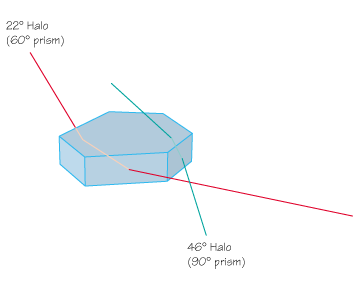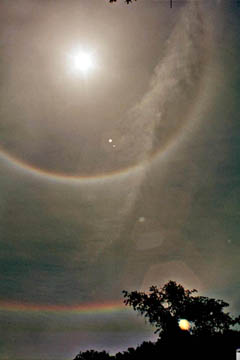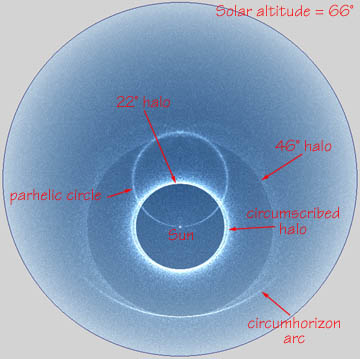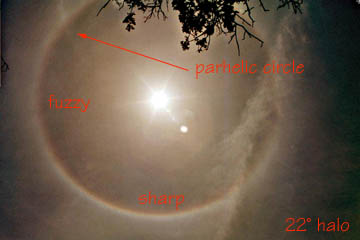
Dear Martha,
Further to my short answer yesterday, here is some more detail about your halo. These are very nice photos - I have not seen many of the lower part of the 46-degree halo (the brightly coloured one at the bottom of the pictures). You have not given me many clues from your emails about how much you know about these phenomena so please forgive me if I hit the wrong level!
Halos like this are produced by refraction and reflection of sunlight (moonlight halos can be seen sometimes as well) by ice crystals in the atmosphere. The crystals are usually high up in cirrus clouds but, under very cold conditions, they can be close to the ground as well - as is often seen in the arctic. The crystals are almost always hexagonal prisms with plane-parallel end faces (top and bottom: see drawing below). They come in many sizes and ratios of length to width and can orient themselves in many different ways in the atmosphere.

Most commonly they float in more-or-less random orientations and it is these which produce the two circular halos around the sun. The smaller one, with a radius of around 22 degrees, is produced when light enters one of the six faces of the hexagon and emerges two faces further on arouind the hexagon. This works like a 60 degree ice prism and explains why the halo is coloured - the red is refracted through a smaller angle than the blue. The halo is sharper on the inside than on the outside because light which passes through the crystal non-symetrically is refracted through a larger angle and appears outside the halo. Most light, however, passes through more-or-less symetrically and suffers 'minimum deviation'.
The bigger halo, with a radius about 46 degrees, is formed in the same kinds of crystals but by light which enters an end face and emerges through one of the 6 side faces (or the other way around). This works like a 90 degree prism and so refracts light through a larger angle and disperses the light more (hence the brighter colours in your outer halo).
 Incidentally, a 90 degree glass prism cannot pass light in this way because its refractive index is too large - larger than ice.
Incidentally, a 90 degree glass prism cannot pass light in this way because its refractive index is too large - larger than ice.
A wealth of other halos can be produced by crystals which float preferentially in horizontal or vertical orientations - eg. thin plates floating with their axes vertical or 'pencils' with their axes horizontal. In your case, the strongly coloured lower arc is a combination of the 46 degree halo - produced by randomly oriented crystals - and the 'circumhorizon arc' - produced by rods which are floating with their axes horizontal. You can see the two stuctures coincide below the Sun but diverge further out (in the simulation below). The corresponding 'circumzenithal arc' (not seen here) touches the 46 degree halo above the Sun and is also highly coloured - and is much more commonly seen (at least by people who look up!) since it appears when the Sun is lower in the sky.
The 'circumscribed halo' which I mentioned before is produced by horizontal rods and explains why your 22 degree halo becomes 'unfocussed' or fuzzy at the sides compared with the top and bottom. See the simulation which shows the halo doubling at the sides.

On one of your pictures, you can also just see part of the 'parhelic circle' - a halo parallel to the horizon and passing through the sun. This is produced by reflections (not refractions) from hexagonal plates and so is uncoloured.

I hope this helps to explain what you saw and photographed. The more I see it, the more I realise that it is splendid and rather unusual display. Congratulations! I strongly recommend that you take a look at the HALO website maintained by my colleagues (of a couple of years) Les Cowley and Michael Schroeder. They have produced a wonderful PC program which simulates all possible halos in a very rigorous way. I used this to compute the simulations here. Their site also gives a lot of explanation. They also give reference to excellent books on the subject.
If you don't object, I should like to use a couple of your photos (with acknowledgment of course) on my website with a brief explanation. Is that OK?
With best regards, Bob Fosbury
Go to Bob Fosbury's homepage